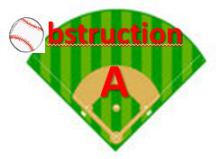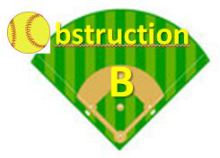Obstruction A and B
How do I enforce the obstruction rule?
There are two types of obstruction that determine if and when the umpire stops play. Otherwise, how you enforce the ruling and make your call are nearly the same.
How do I enforce Obstruction A? – when the play is being made on the obstructed runner
How do I enforce Obstruction B? - when the play is not being made on the obstructed runner
It’s not obstruction until you see it
- Fielders without the ball often stand on a base or in the base path. Doing so does not make them guilty of obstruction. They’re not obstructing unless a runner’s advance or path is altered. Things to look for:
- Did the runner stop?
- Did the runner step to the side?
- Did the runner slow down or hesitate?
- Did the runner slide when he didn’t need to?
- And remember, a fielder with the ball may stand anywhere to make a play and thus would not be guilty of obstruction.
To enforce Obstruction A, immediately call time and direct runners to their bases
Enforcement
- Obstruction A occurs when the play in process is being made on the obstructed runner. Example: a runner veers to the side or slows down to reach second base because the fielder is in the base path (waiting for a thrown ball).
- At the moment the runner's path is altered, immediately call time and award the base
to the runner. The runner is made safe by the ruling whether he was tagged or not prior to reaching the base.
- Award one or more bases to runners based on where you believe they would have reached safely had the obstruction not occurred. Most often it is one base beyond the last
base touched. Example: award home to a runner that was between third base and home plate at the time of the obstruction.
Make Your Call
- Shout your call loudly so everyone understands the ruling. Some umpires will also point to the fielder with a fist. With multiple runners, point at each and instruct them where to go.
- Only the obstructed runner in the field of play
- "Time!" "That's obstruction – runner's safe!"
- Multiple runners
- "Time!" "That's obstruction – runner's safe at second!" "You – go home"! Run scores!" You – first base"!
To enforce Obstruction B, wait for the final play outcome before deciding on a call
Enforcement
- Obstruction B occurs when no play is currently being made on the obstructed runner. Example: the first baseman, standing on first base, causes a runner to slow down as he rounds first on his way to a double.
- Observe the obstruction and allow the play to continue. Decide at that time what base you believe the runner is likely to reach, had it not been for the obstruction. This is referred to as "protecting the runner" to a base. Usually it's one base ahead of the obstruction.
- When all play stops, enforcement depends on the final play outcome.
| If the runner was tagged out at the base he was protected to … | Call “time” and award the base to the runner. The runner is safe. |
| If the runner was safe at the base he was protected to … | Don’t do anything (no time out or obstruction call). Let the play stand. The runner remains safe. |
| If the runner advances beyond the protected base … | Runner advances at his own risk. Let the play proceed. The obstruction ruling is no longer in effect. |
- In most cases, additional runners remain on the bases they reached when the play ended. But any outs on other (non-obstructed) runners are enforced.
- If (in the unusual case) more than one extra base is awarded to the obstructed runner, than all other runners advance accordingly. Example: a batter-runner was on his way to an
easy triple but was tagged out at second after having run into a fielder and falling down. A slower runner who made it to third on the play would be advanced to home because you awarded third
base to the obstructed runner.
Make Your Call
- The Obstruction B call is similar to Obstruction A but requires a bit more explanation by the umpire.
- Only the obstructed runner in the field of play
- “Time!” “I’ve got obstruction at first base.” “Runner’s safe at second.”
- No need to give directions to other runners. They stay at the base they reached (except in the example above of an obstructed runner that is awarded more than one base).



